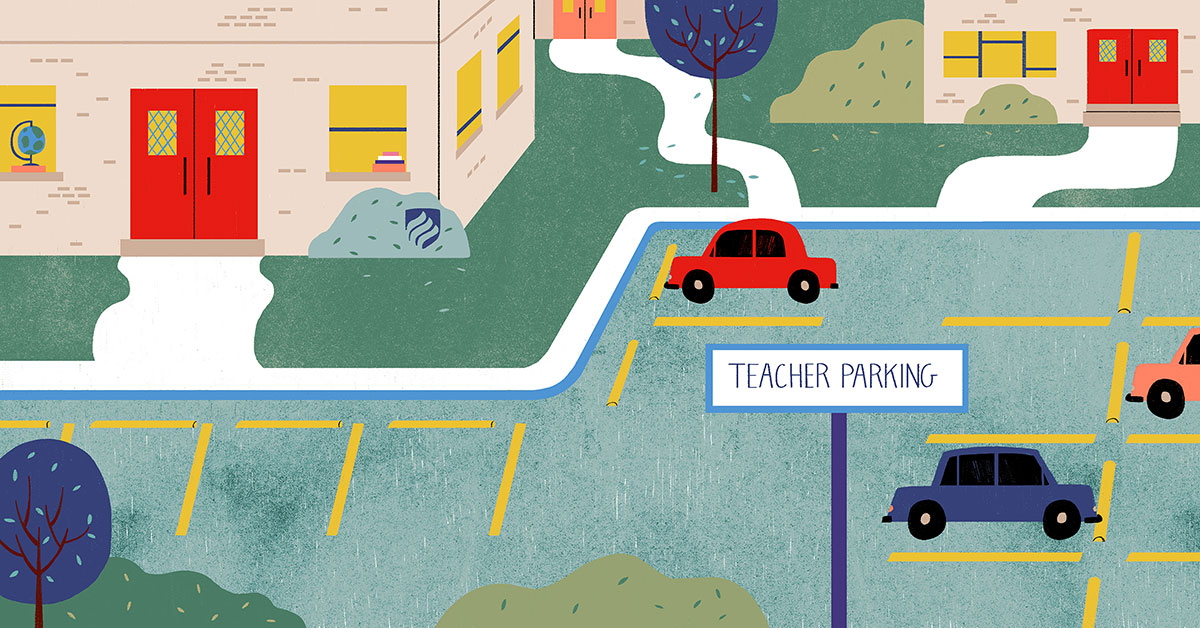Remedying the Teacher Shortage by Diagnosing Why a Shortage Exists
CHALKING THE LINE | BY DEBRA MEYER | 8 MIN READ

Popular Searches
CHALKING THE LINE | BY DEBRA MEYER | 8 MIN READ

In economics, a shortage happens when the demand for some good or service is greater than its supply. I just read that we have a small-chicken shortage because spicy chicken sandwiches are in demand and fast-food restaurants are competing for the limited supply of small chickens used to make these sandwiches. Sounds like we need more small chickens—or a new type of fast food to shift the demand. With that said, let’s talk about the teacher shortage.
In the education world, the news stories about a teacher shortage have grown more alarming over the last decade. But should we really be calling it a shortage? Is the solution to “produce” more teachers quickly and in large numbers?
Or does the solution lie in how we attract and retain the best teachers—in other words, looking at why the shortage exists?
One of my favorite arguments on this issue was made by Peter Green in a Forbes online article from September 2019, “We Need to Stop Talking About the Teacher Shortage.”
Here’s an excerpt from Green’s argument:
You can’t solve a problem starting with the wrong diagnosis. If I can’t buy a Porsche for $1.98, that doesn’t mean there’s an automobile shortage. If I can’t get a fine dining meal for a buck, that doesn’t mean there’s a food shortage. And if appropriately skilled humans don’t want to work for me under the conditions I’ve set, that doesn’t mean there’s a human shortage.
I agree with Greene that the solution to not having enough teachers willing and able to fill teaching positions is not about increasing production and making it easier to become a teacher. The solution is about attracting and retaining teachers in a profession they find meaningful and in which they feel valued. This is a complex problem that will take a multifaceted approach. But the diagnosis is clear, and in some schools, states, and countries the remedies are working.
Let’s look at three interrelated contributors to the current teacher shortage: competitive salaries, professional work conditions and teacher turnover.
When schools pay more, they have more teachers apply for positions. The need for teachers is most acute in schools that pay the lowest salaries, which are often located in places where few teachers live or want to move (e.g., rural communities, urban neighborhoods, Alaska).
The Learning Policy Institute’s latest report, for 2018, found that when teachers graduate from college, their beginning salaries are 75% of what the average college graduates can expect (approximately $38,617 was the national average in 2016 and 2017).
Illinois just passed legislation to raise minimum base teacher salaries to $40,000 by 2023 to address its teacher shortage. Chicago Public Schools (CPS), which employs just over 21,000 teachers, has an entry salary of $56,000 per year, which ranks 22nd out of the largest 124 school districts in the U.S. although CPS is the third-largest school district in the U.S. behind New York City and Los Angeles Unified.
When looking at any list of the top salaries for teachers, they are often located in the wealthiest communities, which means lots of applicants. This intersection of salary and geographic location is similar to what we see in other professions, such as the shortage of doctors in rural areas, but not wealthy communities.
Making teachers’ salaries competitive will be necessary but insufficient to attract and keep the best teachers in the classrooms. Teachers cannot be paid enough to work in a toxic environment.
There are many factors that contribute to a professional culture and climate: the qualifications of the other educators, the respect given to educators, the rate of turnover, the quality of professional development and leadership opportunities, etc. Salary and benefits are part of demonstrating that teachers are valued, but equally important are how people show respect and celebrate accomplishments. High morale attracts and retains teachers.
When systems—district, state, national—devalue teachers by paying them less, hold them singularly accountable for student test scores, and don’t provide support or essential resources, the work environment deteriorates. Discourse about teaching and teachers also contributes to declines in the psychological environment, with labels like “failing schools” getting tossed around.
Also detrimental are the political decisions, especially local ones, to underfund schools. One of the most problematic indicators of decline in teachers’ professional work environments is the increasing number of people, including teachers, who do not want their own children to enter the profession. (The PDK poll goes more in depth on the public’s attitude toward public schools.)
Work environments are complex, and as they fragment it becomes more difficult to put the pieces back together. The Learning Policy Institute’s 2018 report found that, across the U.S., 71% of teachers reported feeling they had control of the curriculum and methods in their classrooms. However, 12% of teachers felt their jobs were in jeopardy due to testing and test scores. Half (50%) of the teachers taking the survey said that they had administrative support and encouragement. But only 39% of teachers reported a feeling of collegiality in their school. These statistics highlight how working conditions contribute to teachers leaving the profession.
The teacher shortage itself contributes to the devaluation of the profession and loss of morale. As Emma Garcia and Elaine Weiss wrote for the Economic Policy Institute: “The teacher shortage makes it more difficult to build a solid reputation for teaching and to professionalize it, which further contributes to perpetuating the shortage.”
But where the work environment is positive and professional, teachers thrive—and so do their students. For example, in Finland, teachers are held in esteem and are trusted professionals. In a story for The Atlantic, Timothy D. Walker interviewed a Finnish teacher who had moved to the U.S. and began teaching. Her comparison of the two countries’ views of teachers illustrates the psychological foundation of a positive work environment for teachers.
Teacher turnover is high in the United States and contributes to shortages. And turnover is related to both salaries and work environment. When teachers’ salaries are more competitive and working conditions better, teacher turnover has been at its lowest level. We see low turnover rates of 4%-5% in countries (e.g., Finland, Singapore) and states (e.g., Massachusetts) that keep salaries competitive and support high-quality teacher preparation.
The combination of professional preparation and compensation demonstrates a respect for teachers, which also supports better work environments. So it is no surprise that finding and retaining teachers is not a problem in places where teachers are well-supported by their colleagues throughout their careers.
When supports are not in place, teachers leave the classroom. Richard Ingersoll, a professor at the University of Pennsylvania who follows teacher retention data, recently reported that 44% of teachers leave in their first five years, with a large percentage leaving after only one year.
The Learning Policy Institute’s 2018 report on understanding teacher shortages found that, on average, 12.7% of teachers in U.S. schools were in their first or second year and 2.6% of teachers in classrooms had not yet been fully licensed (they were on emergency temporary licenses because the teaching positions could not be filled). In addition, 7.3% of teachers said they were planning on leaving the profession.
That means almost a quarter of all teachers were inexperienced or already planning on leaving at the time of the survey. Which students are assigned to their classrooms? How could they be better supported and retained? This is a key part of the diagnosis for why teachers are leaving.
So what’s the prescription? Where new teachers are exceptionally well-prepared, well-paid and well-supported, the teacher shortage is not a problem.
I see these success stories every day in my work as a teacher educator, and at the same time I know that the successes are happening in isolated school districts, or even schools within a district. There is a complex balance that needs to be struck between salary, work environment and the support teachers need throughout their careers. The “teacher shortage” does not exist everywhere, and that’s because some areas have successfully diagnosed how to attract and retain the best teachers.
I will address these recruiting and retention strategies in a future post. In the meantime, I hope you will share your experiences with and perspectives on the “teacher shortage” in the comments.
Check out the Learning Policy Institute’s 2018 interactive maps to understand the teacher shortages state-by-state in terms of “teaching attractiveness ratings” and “teacher equity ratings.”
If you have a passion for teaching, develop your skills at Elmhurst University. We offer the M.Ed. in Teacher Leadership and other advanced degree options in education. Use the form below to let us know you are interested!
 Deb Meyer is a professor of education at Elmhurst University and a former classroom teacher in Mesa, Arizona. She teaches undergraduate courses to prospective teachers in educational psychology and upper elementary/middle school literacy methods and graduate courses in teacher leadership.
Deb Meyer is a professor of education at Elmhurst University and a former classroom teacher in Mesa, Arizona. She teaches undergraduate courses to prospective teachers in educational psychology and upper elementary/middle school literacy methods and graduate courses in teacher leadership.
Illustration by Josie Portillo
Posted Feb. 18, 2020